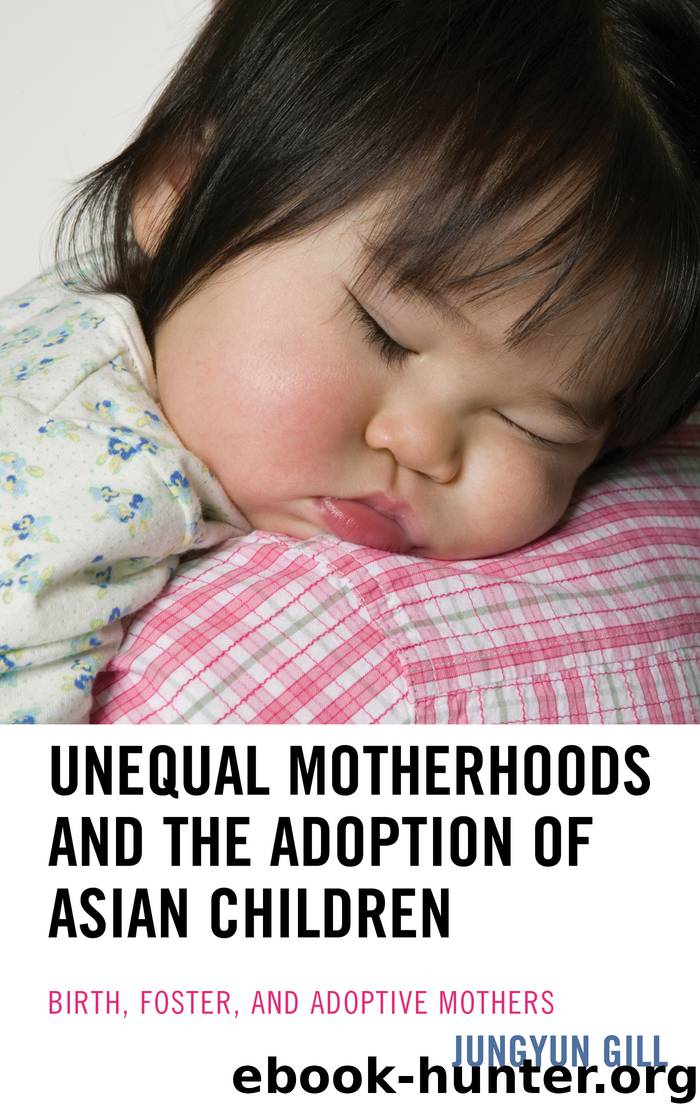Unequal Motherhoods and the Adoption of Asian Children by Gill Jungyun;

Author:Gill, Jungyun;
Language: eng
Format: epub
Tags: undefined
Publisher: Lexington Books/Fortress Academic
Published: 2012-08-15T00:00:00+00:00
As described earlier, foster mothers tended to experience enormous emotional difficulty when and after their foster children were sent to adoptive parents. Some of them felt like they gave away to strangers children they loved and had worked so hard to raise. Not knowing what happened to their foster children enhanced the pain of separation. Meeting the grown-up children who they had foster-cared, especially those with health issues or disabilities, provided foster mothers with comfort and assurance. Like Jum-Sun Noh, foster mothers felt pride in their mothering work when they visited adoptees and their families abroad and had a chance to actually witness the living environment of their adopted children.
In conclusion, as in the case of birth mothers, how foster mothers are documented varies by countries. The absence of information about foster care from documentation can make foster mothersâ care and motherhood almost totally invisible to U.S. adoptive mothers. In most of the Korea adoption cases, adoption documents provided to adoptive parents usually included some basic information about the foster care such as foster parentsâ names, ages, and education. But this limited information does not reveal the multiple layers of foster mothersâ motherhood and mothering. My field research revealed that despite foster mothersâ crucial role during the adoption process, that is, caring for mostly newborns right after the agency took them in for adoption and until they were sent to adoptive parents, foster mothers in Korea were not their agencyâs employees but were instead classified as âvolunteersâ for the agency. This status contributed to their poor payment levels, far lower than the minimum wage in Korea, and lack of work benefits. Since older women with little education have extremely limited opportunities for paid work in Korea, some of them become foster mothers. Itâs these womenâs mothering labor that is exploited in the process of international adoption. Foster mothersâ stories indicate that caring for infants is very exhausting and involves sacrifice of personal lives. But their foster children also give them and their family happiness. The hardest part of their foster care work is the emotional difficulty and stress involved in sending their foster children to strangers, the adopting parents, after raising the children as their own. Although foster mothers are not legally or biologically related to the children in their care, doing maternal work for foster children entails maternal identity and bonding to the children. Being often encouraged by adoption social workers, some adoptive mothers and foster mothers went beyond the adoption document-mediated relationship by exchanging letters, photos, and other gifts. Photo albums from foster families are the visual presentations of foster mothersâ care for the children. While many adoptive mothers of Korean adoptees express affection and admiration for foster mothers, they generally do not realize that foster mothers who sent Han-Bok, photo albums, or toys to adoptive parents might have spent their earnings for a couple of daysâ foster care labor to buy these gifts. Since adoption documents do not include any information about how little foster mothers were
Download
This site does not store any files on its server. We only index and link to content provided by other sites. Please contact the content providers to delete copyright contents if any and email us, we'll remove relevant links or contents immediately.
Cecilia; Or, Memoirs of an Heiress — Volume 1 by Fanny Burney(32074)
Cecilia; Or, Memoirs of an Heiress — Volume 3 by Fanny Burney(31469)
Cecilia; Or, Memoirs of an Heiress — Volume 2 by Fanny Burney(31419)
The Great Music City by Andrea Baker(30795)
We're Going to Need More Wine by Gabrielle Union(18641)
All the Missing Girls by Megan Miranda(14785)
Pimp by Iceberg Slim(13797)
Bombshells: Glamour Girls of a Lifetime by Sullivan Steve(13698)
Fifty Shades Freed by E L James(12924)
Talking to Strangers by Malcolm Gladwell(12888)
Norse Mythology by Gaiman Neil(12858)
For the Love of Europe by Rick Steves(11554)
Crazy Rich Asians by Kevin Kwan(8898)
Mindhunter: Inside the FBI's Elite Serial Crime Unit by John E. Douglas & Mark Olshaker(8718)
The Lost Art of Listening by Michael P. Nichols(7169)
Enlightenment Now: The Case for Reason, Science, Humanism, and Progress by Steven Pinker(6879)
The Four Agreements by Don Miguel Ruiz(6324)
Bad Blood by John Carreyrou(6284)
Weapons of Math Destruction by Cathy O'Neil(5844)
